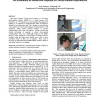Free Online Productivity Tools
i2Speak
i2Symbol
i2OCR
iTex2Img
iWeb2Print
iWeb2Shot
i2Type
iPdf2Split
iPdf2Merge
i2Bopomofo
i2Arabic
i2Style
i2Image
i2PDF
iLatex2Rtf
Sci2ools
VR
2008
IEEE
2008
IEEE
An Evaluation of Immersive Displays for Virtual Human Experiences
This paper compares a large-screen display to a non-stereo head-mounted display (HMD) for a virtual human (VH) experience. As VH experiences are increasingly being applied to training, it is important to understand the effect of immersive displays on user interaction with VHs. Results are reported from a user study (n=27) of 10 minute human-VH interactions in a VH experience which allows medical students to practice communication skills with VH patients. Results showed that student self-ratings of empathy, a critical doctor-patient communication skill, were significantly higher in the HMD; however, when compared to observations of student behavior, students using the large-screen display were able to more accurately reflect on their use of empathy. More work is necessary to understand why the HMD inhibits students’ ability to self-reflect on their use of empathy.
Large-screen Display | Non-stereo Head-mounted Display | Vh Experience | Virtual Reality | VR 2008 |
| Added | 01 Jun 2010 |
| Updated | 01 Jun 2010 |
| Type | Conference |
| Year | 2008 |
| Where | VR |
| Authors | Kyle Johnsen, Benjamin Lok |
Comments (0)

